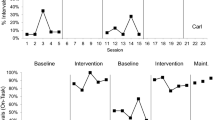Abstract
We examined the effects of an individualized schedule on levels of engagement and self-injury for a student with severe autism. We first conducted a series of functional analyses to identify contexts in which self-injury occurred in his classroom. Results of the functional analyses suggested that self-injury was associated with academic demands. Self-injury rarely occurred during the play and no interaction conditions (i.e., when the teacher was present but did not attend to him) of the functional analysis. Furthermore, when the functional analysis conditions were organized according to a specific schedule (no interaction–play–demand) self-injury did not occur. This schedule of activities was then evaluated within the context of his regular curriculum and produced substantial reductions in self-injury and increases in engagement. Positive results maintained for up to five months following the assessment. These findings seem to indicate that functional analysis methodologies might provide helpful information when developing individualized schedules for students who may not have the skills to comprehend and follow a schedule.
Similar content being viewed by others
References
F. Brown (1991) ArticleTitleCreative daily scheduling: A nonintrusive approach to challenging behavior in community residences Journal of the Association for Persons with Severe Handicaps 16 75–84
E. G. Carr C. D. Newsom J. Binkoff (1976) ArticleTitleStimulus control of self-destructive behavior in a psychotic child Journal of Abnormal Child Psychology 4 139–153
L. J. Heflin R. L. Simpson (1998) ArticleTitleInterventions for children and youth with autism: Prudent choices in a world of exaggerated claims and empty promises. Part I: Intervention and treatment option review Focus on Autism and other Developmental Disabilities 13 194–211
R. H. Horner E. G. Carr P. S. Strain A.W. Todd H. K. Reed (2002) ArticleTitleProblem behavior interventions for young children with autism: A research synthesis Journal of Autism and Developmental Disorders 32 423–446
B. Iwata M. Dorsey K. Slifer K. Bauman G. Richman (1994) ArticleTitleToward a functional analysis of self-injury Analysis and Intervention in Developmental Disabilties 2 1–20
B. Iwata T. Vollmer J. Zarcone (1990) The experimental (functional) analysis of behavior disorders: Methodology, applications, and limitations A. N. Repp Singh (Eds) Perspectives on the use of nonaversive and aversive interventions for persons with developmental disabilities Sycamore Publishing Company Sycamore Ill. 301–330
T. Knoster (2000) ArticleTitlePractical application of functional behavioral assessment in schools Journal of the Association for Persons with Severe Handicaps 25 201–211
Lalli (1994) ArticleTitleTreatment of escape-maintained aberrant behavior with escape extinction and predictable routines Journal of Applied Behavior Analysis 27 705–714
G. Mesibov D. Browder C Kirkland (2002) ArticleTitleUsing individualized schedules as a component of positive behavioral support for students with developmental disabilities Journal of Positive Behavioral Support 4 73–79
E. Schopler R. J. Reichler B. R. Renner (1988) The childhood autism rating scale (CARS) Western Psychological Services Los Angeles
J. Sigafoos M. Arthur M. F. O’Reilly (2003) Challenging behaviour and developmental disability Whurr Publishers London
S. S. Sparrow D. A. Balla D. V. Cicchetti (1984) Vineland adaptive behavior scales: Interview edition American Guidance Service Circle Pines
P. Sturmey (1995) ArticleTitleAnalog baselines: A critical review of the methodology Research in Developmental Disabilities 16 269–284
Author information
Authors and Affiliations
Corresponding author
Rights and permissions
About this article
Cite this article
O’Reilly, M., Sigafoos, J., Lancioni, G. et al. An Examination of the Effects of a Classroom Activity Schedule on Levels of Self-Injury and Engagement for a Child with Severe Autism. J Autism Dev Disord 35, 305–311 (2005). https://doi.org/10.1007/s10803-005-3294-1
Issue Date:
DOI: https://doi.org/10.1007/s10803-005-3294-1




